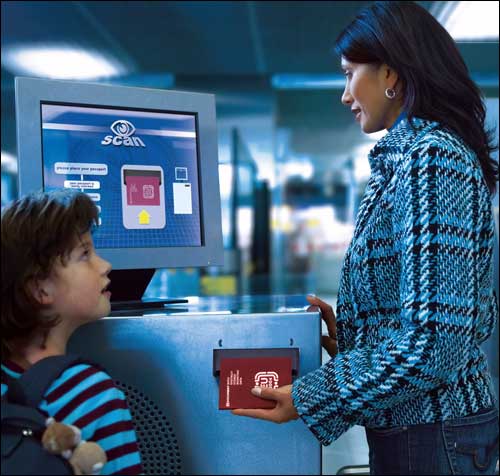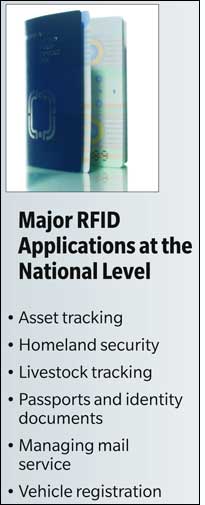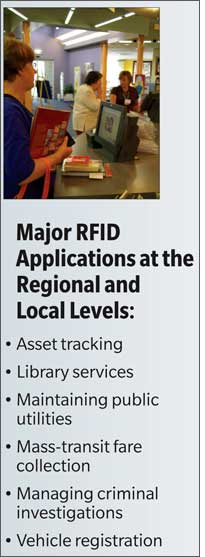Doing more with less has become a mantra for governments at all levels worldwide. As agencies strive to meet service goals while keeping a lid on costs, radio frequency identification is playing an important role in an array of public-sector projects. Some of these initiatives were funded and launched before the economic crisis hit, while others are being created or enhanced by a flow of stimulus money.
The relationship between RFID and governments is not new. For more than a decade, governments have played a pivotal role in RFID’s development, pioneering applications in such diverse areas as military asset management, environmental monitoring and personal identification. Many national governments are employing RFID to track livestock so animals can be identified quickly in the event of a food recall or disease outbreak. And a number of city governments—from Boston to Moscow, Paris and Seoul—have deployed public transit fare-collection systems, which eliminate costly human intervention while providing increased speed and accuracy.
|
|
Now, in these uncertain times, RFID promises to help governments perform a wide range of vital tasks more efficiently. Some, such as keeping the food supply safe and fit for consumption, are still in the nascent stages. In Norway, for instance, the government has set a 2010 deadline for developing standards and policy regarding food traceability. The project is part of its eTraceability program, intended to increase food safety by providing visibility from the farm to the store. Similarly, in Hawaii, the Hawaiian Department of Agriculture has launched an RFID pilot designed to help track produce through the supply chain. Its goal is to provide traceability whenever food safety becomes a concern, as well as to create an audit trail that will help farmers, retailers and distributors monitor the movement of fresh produce.
Other applications—from monitoring homeland security to tracking library books—have proved their mettle. They are good examples for governments at all levels of how RFID can help facilitate services during these challenging times. (To learn more about the RFID projects cited here—which are too numerous to cover in depth—you can read the complete news report or case study on RFIDJournal.com.)
On the National Front
Despite tightening budgets, many government-sponsored RFID projects are continuing to move forward. “Unlike most other areas, government RFID is recession-proof,” says Raghu Das, CEO of IDTechEx, an RFID industry market research firm. According to IDTechEx, the ongoing growth of the RFID market is due, in large part, to government-led RFID schemes, such as those for transportation, national IDs (contactless cards and passports), the military and animal tagging.
In the United States, most government-sponsored RFID initiatives are focused on two areas: military applications and homeland security. Recently, however, there has been a gradual move toward partnerships between the government and the private sector. In Europe, government-sponsored RFID projects have been widespread for the better part of a decade. These initiatives, often funded by the European Union, are primarily joint ventures between government entities—including universities—and private businesses. RFID ventures between governments and businesses are popular in some parts of Asia as well.
Even with the economy unraveling, RFID Global Solution CEO Diana Hage sees a bright future ahead for RFID and the U.S. government as agencies work to build greater efficiencies into everyday operations while simultaneously attempting to stimulate the economy. This means an expansion from military and security applications into a greater number of civilian-oriented projects, such as medical services and the environment. “I would say with the incoming Obama administration, you’re going to see increased uptake of the service technology in some of the civilian-focused agencies because it provides all the same efficiencies, and now we can apply it to our local economy,” Hage says. “It doesn’t have to just be around military shipping.” Monitoring food safety and enhancing public services, such as mail delivery, can also be helped by RFID-enabled technologies, she notes.Asset Visibility and Public Protection
When it comes to national-government RFID projects worldwide, asset visibility sits at the top of the list of applications. “I would say that asset visibility is a very fundamental driver, particularly in the defense and federal arenas,” Hage says. “A lot of [RFID adoption] is driven by military logistics and the need to have greater insight into items as they’re moving throughout the military supply chain.” The U.S. Department of Defense (DOD), for instance, is currently using RFID to help it eliminate waste, improve services and bolster security in its highly complex supply chain (see Targeted Attack).
Governments worldwide are feeling pressure to secure their borders and protect their citizens from terrorist attacks. Many governments now view RFID as an ideal tool to monitor everything from cargo shipments to people. “The TSA [Transportation Security Administration] recently put out a grant to…the chemical industry, where the guys haul hazardous chemicals over our nation’s railroads, to give grant money to facilitate putting AIT [automatic identification technology]-enabled security devices on the railcars loaded with hazardous cargo,” says David Shannon, senior VP of product management and strategy at Savi Technology, an RFID systems developer. “This all started through an industry initiative, driven by Dow Chemical, to demonstrate that they could monitor the security of their hazardous cargo and provide that information to the TSA.”
Governments also have an intense interest in adopting RFID-enabled passports and other identity documents. The technology is widely viewed as a powerful way to enhance border security and speed up immigration processing—all at a relatively low cost, says Jim Sheire, government programs manager for RFID chip maker NXP Semiconductors. In addition, citizen ID cards are used in many countries to provide a more efficient way to give people access to government services, including health care. “Some of the countries where we’re seeing governments adopt smart cards for citizen ID are Austria, France and Germany, but also in places like India, Indonesia, Morocco in North Africa, and Thailand,” Sheire says.
IDTechEx’s Das observes that a growing number of governments are settling on RFID for document security because it’s the only available technology that meets all their needs. “For example,” he says, “when the Chinese government wanted to put out a national ID card, they didn’t say, ‘We want an RFID tag’; they said, ‘We want a national ID card, and it would be convenient if it was wireless’—and that happens to be an RFID device.”
Yet even as national governments rush toward RFID-enabled identity documents, there are still concerns about privacy and the potential misuse of RFID technology to track and monitor people. RFID identity systems must undergo thorough privacy impact assessments before design and deployment, says Jeremy Godfrey, CIO with the government of Hong Kong. “There will be legitimate public concerns,” he says, “and you need to make sure you address them.”
Mail Management
Keeping the mail moving is turning out to be another prime RFID application, now being adopted by national postal authorities worldwide. The Spanish Postal Service, which already has one of the world’s largest RFID deployments, recently expanded its tracking system from 16 to 56 sorting centers across Spain. The system uses RFID to monitor the flow of mail and track the reusable bins that transport letters from location to location (see Spanish Postal Service Expands Its RFID Deployment).
In another part of Europe, Swiss Post, having completed two successful RFID rollouts, has moved to its third application: a system that tracks the rolling container cages used to transport mail. The project is expected to help the public company manage the cages more effectively, and it could save the organization 1.5 million Swiss francs ($1.4 million) a year (see Swiss Post Delivers RFID to Its Parcel Centers, Transportation Hubs).In Saudi Arabia, Saudi Post is rolling out RFID-based mailboxes for citizens across the kingdom. The system is designed to help managers verify when mail was delivered to a particular home, while providing real-time updates on carriers’ locations. Previously, Saudi Arabia had no unified addressing system, causing confusion and delays for packages and mail (see Saudi Post Adds Intelligence to Mailboxes).
Australia Post has deployed more than 400 RFID interrogators at mail-sorting and distribution centers across the country, tracking 12,500 special RFID-tagged envelopes as they pass through key network sorting points. The agency can now better understand the performance of the mail system and spot inefficiencies in its network (see Aussies Track Mail Service via RFID).
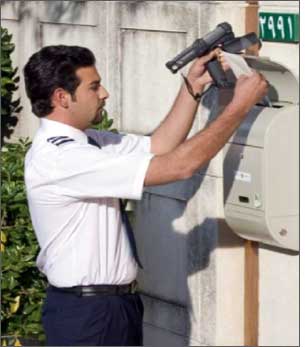
China Post deployed an EPCglobal-compliant RFID project that tracked bags of express mail delivered within the district of Shanghai. This initiative was part of an ongoing national pilot project, cosponsored by China’s Ministry of Science and Technology, to validate the benefits of RFID within China Post’s operations (see China Post Deploys EPC RFID System to Track Mailbags).
Vehicle Registration
With more governments interested in the efficient tracking and monitoring of motor vehicles for safety, revenue-generation and environmental purposes, RFID is providing a way to pinpoint both car and truck location as well as vehicle ownership. Bermuda recently moved to RFID vehicle registration, applying 25,000 tags to cars and trucks. With RFID helping to reduce the number of unlicensed vehicles, the tiny island nation could reclaim an estimated $2 million per year (see Bermuda’s RFID Vehicle Registration System Could Save $2 Million/Year).
In South Africa, RFID is being used to identify vehicles and confirm they are properly registered. With 500,000 tags already affixed and an additional 10 million cars expected to be tagged within a two-year period, South Africa is well on its way to joining Brazil and other countries that have begun to crack down on unregistered vehicles (see Electronic Vehicle Registration Picks Up Speed).
Regional and Local Projects
While most government-sponsored RFID initiatives play out on a global or national stage, a steadily growing number of deployments are now popping up in specific regions, cities and communities. Many of these RFID deployments are designed to help governments themselves increase their efficiency in processes such as public utility maintenance and criminal investigation management. Others aim to create new and innovative services for residents and businesses.
Some local governments are also beginning to invest in public-private partnerships. The City of Dayton, Ohio, for example, has announced plans to create an RFID-focused business incubator, bringing together entrepreneurs, scientists, technology providers and potential users to foster the growth of RFID solutions. The $6 million facility will be the result of collaboration between EPC Technologies, the City of Dayton, and CityWide Development, a nonprofit organization that aims to improve economic growth in the Dayton area (see Dayton to Foster New RFID Solutions).Public Utilities
As a resource used by virtually all residents and businesses, public utilities are an obvious choice for streamlining and modernization through RFID. In Germany, Berliner Wasserbetriebe, the utility company that provides drinking water and sewage services for the city of Berlin, has designed an RFID application that automatically inventories its equipment and provides an enhanced overview of the condition and location of machinery and other assets (see Berliner Wasserbetriebe Gets RFID Tagging Project Flowing).
Elsewhere in Germany, in the town of Warendorf, RFID is being used to track the maintenance of the city’s 205-kilometer (127-mile) network of sewage pipes. The system provides employees with non-paper-based work orders, and allows them to record the status of the pipes as they perform their duties (see RFID Keeps City Sewers Running Smoothly).
The London Underground also is using RFID to improve its maintenance operations, having begun the rollout of an RFID application that will track the maintenance of tube station escalators. With a more efficient maintenance process, the agency hopes to improve the safety of the escalators used by the Underground’s 3 million daily passengers (see At the London Underground, RFID Keeps Escalators Moving).
Laredo, Texas, has turned to an early warning system that combines sensors, RFID seals and motion detectors to monitor and protect its drinking water. The technology is designed to provide an added level of security at the Jefferson Street Water Treatment Plant, which uses the Rio Grande as its source for Laredo’s drinking water (see Laredo’s Water Department Uses RFID to Maintain Law and Order).
Asset Tracking
Like national governments, regional and local authorities are looking to RFID to facilitate asset tracking in order to gain greater visibility over their high-value items. In Australia, for instance, the Melbourne city council has expanded its use of RFID by turning its fleet-tracking trial into a fully automated asset-management system. Detailed data on the use of each of the monitored vehicles is essential to the council, due to the varying rate each department is charged. By automating the data-collection process with RFID, the council believes it will save up to AU $40,000 (US $35,000) per year (see Melbourne City Council Tracks Its Car Fleet).
At the John C. Daniels Elementary School in New Haven, Conn., administrators have more on their mind than reading, writing and arithmetic: The New Haven Public Schools district has deployed an RFID pilot at the elementary school to track its many desktop and laptop computers. The system is designed to maximize computer use in the school while reducing the potential expense of laptop theft (see New Haven Public Schools Keeps Tabs on Laptops).
RFID is often used by governments to track valuable items, but in California’s Alameda County, the technology is tracking something invaluable: voter ballots. By turning to RFID, the county has been able to process votes more quickly, as well as minimize the opportunity for ballot tampering (see Alameda County Gives RFID Ballot-Tracking a Vote of Approval).Crime Investigations
While RFID is being used by governments to address national security issues, the technology also can be applied to the investigation of local crimes. In the Netherlands, the Dutch Forensic Institute has installed an item-level RFID solution to track and trace crime-scene evidence collected by the authorities. Once evidence has been checked in, the system captures the exact date and time whenever items are moved between departments during an investigation (see Dutch Forensic Institute Uses RFID to Control Crime Evidence).
Santa Clara, Calif., has built a new $75.5 million crime lab equipped with a clean room for computer forensics work. The facility includes an RFID track-and-trace system for evidence, to make it easier for crime lab researchers to account for every tire print, cigarette butt and fiber sample brought in for testing (see Santa Clara Crime Lab Turns to RFID).
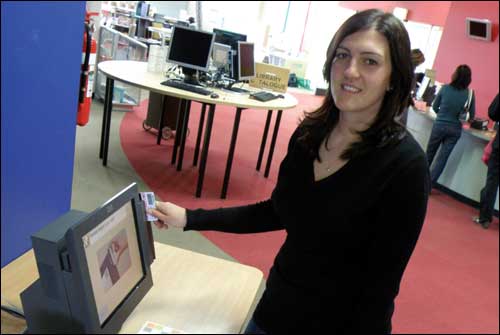
In Texas, the Travis County Fire Marshall’s office has rolled out an RFID-based evidence-management system to keep track of the ever-increasing number of items necessary to prosecute fire-related events. The statute of limitations on such crimes has increased over the years, making it difficult to track items with the same Excel spreadsheets the agency had been using for some time. By implementing RFID, the authorities are able to easily locate evidence when it’s needed (see Travis County Fire Marshall Uses RFID to Manage Evidence).
Mass Transit
Residents of Lyon, France, have been using their Técély RFID-enabled transit passes for many years to pay for their bus, tramway and Metro fares. Now, they can use their passes to pay for bike rentals as well. More than 2,000 bicycles are available through this application, which has been called CycleCity. The program’s goal is not to create a profit, but to promote bicycling in Lyon (see Bike Rental Program Peddles Smart Cards).
In Montreal, the city’s parking authority, Stationnement de Montréal, is taking RFID local with a bicycle rental system based on the technology. Jeff Desruisseaux, the agency’s business development manager, says public support for a local RFID-based project is crucial to its success. “Interacting with the local community to build public support is essential,” he says. “We were quite fortunate in that the population welcomed our project with open arms” (see Montreal RFID-Enabled Bike Project Picks Up Speed).
In the Netherlands, the Amsterdam Tourism & Convention Board has created an RFID-enabled visitor pass. The prepaid card will allow travelers to access not only the city’s public transit system but also a wide variety of museums and other local attractions (see Amsterdam Tourists Go Contactless).
Swiss public transport agency Verkehrsbetriebe St. Gallen has begun a pilot that will assist blind and visually impaired riders using public transportation. The RFID-based system will allow passengers to check transit information at bus stops, determine the destination of passing busses, and alert bus drivers that they would like to board the vehicle (see Swiss Town Rolls Out RFID System for Blind Bus Riders).Community and Social Services
A need to keep the people who use various government services happy and satisfied also inspires many governments to look at RFID solutions. “Governments are trying to become a lot more focused on customer satisfaction,” says Hong Kong’s Godfrey. “Governments realize that the users of their services need to be treated like customers, so we need to provide them with services that are as convenient and as efficient to use as the services they get from the private-sector companies.”
Libraries around the world have heeded this message. In Australia, for example, the Yarra Plenty Regional Library—the second-largest library in Melbourne—recently completed an RFID deployment that allowed the library to move to a self-service book checkout system, freeing staff members to focus on other activities. “We built our business case around the argument that RFID would help us provide better services to our customers and reduce the occupational health and safety risks for our staff,” says Christine Mackenzie, the library’s CEO.
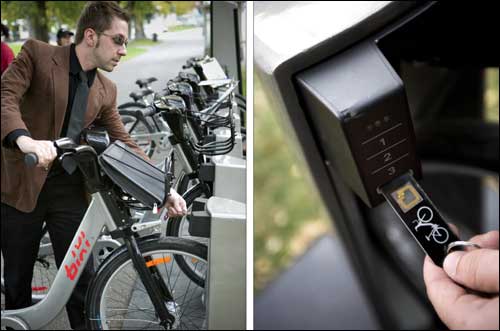
Like municipal agencies worldwide, Yarra Plenty is required to follow government procurement rules. For its RFID project, this meant going through a lengthy tender process. “We first asked the industry for an expression of interest in order to understand the market and what was available,” Mackenzie says. “We then short-listed two vendors from seven responders, and asked them to tender for the RFID solution.”
With the system in place, Yarra Plenty is looking forward to enjoying its benefits. “We expect that now that RFID is fully operational, we will be able to reduce our replacement staffing costs—something that will be important for us, as this budget round will be tighter than in previous years,” Mackenzie says.
Library officials in Paris have announced that they will be installing RFID technology at 42 branches to better manage circulation, inventory and security. With the installation of 3 million tags, as well as workstations, interrogators, detection gates and self-checkout systems, the program will allow customers to perform a variety of tasks without staff assistance (see “Parisian Libraries to Implement RFID”).
In communities worldwide, RFID is showing a great deal of potential for helping governments and residents cope with both short- and long-term crises. In the Netherlands, for instance, Werk aan de Wijk, an organization that provides the elderly with social services such as household chores and meal preparation, has adapted Near Field Communication-enabled mobile handsets for use as point-of-sale terminals. The phones enable workers to document the length of time spent in each client’s home, and to receive payment for services rendered (see Dutch Agency Employs RFID to Track Social Services).
The Anaheim Fire Department in California has turned to RFID to be better prepared for any disaster. In addition to an RFID-based triage solution, designed for use in wide-scale emergencies, fire stations can now inventory their equipment with RFID (see Anaheim Fire Department Deploys Multipronged RFID System).
IDTechEx’s Das feels that RFID is just beginning to reach its potential in government applications. “By deploying RFID for their purposes and for the benefit of their citizens, [governments] are also helping to advance the technology,” Das says. “They are helping to lay the foundation not only for future RFID uses in their own country or locality, but to assist the creation of new and innovative RFID applications for a wide range of other government projects.”
Montreal’s Desruisseaux believes that as government leaders and the public become more comfortable with RFID, the number of local deployments will climb. “With time,” he predicts, “the use of RFID technology will become more widespread.”

